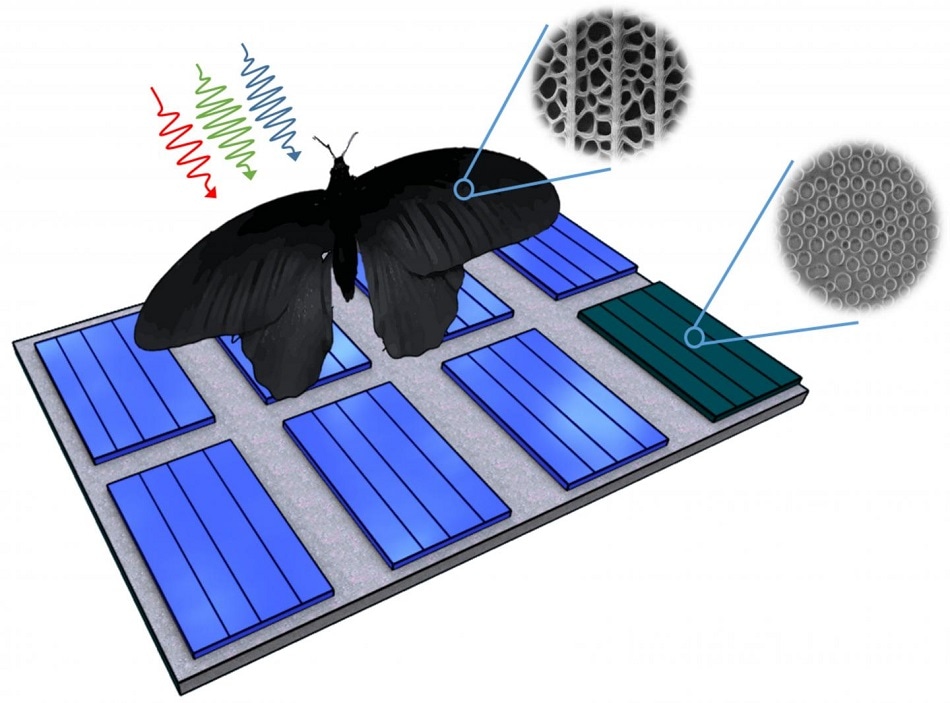Micro- and nanostructures found in the wings of a jet black butterfly native to Asia help optimize light absorption, a principle which German scientists have applied to photovoltaics to boost their light harvesting ability and increase solar cell efficiency.
 Image Credit: Radwanul H. Siddique, KIT/Caltech
Image Credit: Radwanul H. Siddique, KIT/Caltech
Nanostructures of the wing of Pachliopta aristolochiae can be transferred to solar cells and enhance their absorption rates by up to 200 percent.
The wings of the butterfly Pachliopta aristolchiae are incredibly dark black, and drilled with micro- and nanostructures which help it absorb light over a wide spectrum far better than a smooth surface would. Researchers from Karlsruher Intitut für Technologie (KIT) have taken inspiration from this Southeast Asian insect, transferring such nanostructures to solar cells.
Reporting in Science Advances, the researchers state they have enhanced the absorption rate of their thin film solar cells by up to 200%. The sunlight reflected by solar cells is lost as unused energy, so increasing their light-harvesting ability, and therefore efficiency, is incredibly important.
The butterfly studied by us is very dark black. This signifies that it perfectly absorbs sunlight for optimum heat management. Even more fascinating than its appearance are the mechanisms that help it reach the high absorption. The optimisation potential when transferring these structures to photovoltaics (PV) systems was found to be much higher than expected.
Dr Hendrik Hölscher, Institute of Microstructure Technology (IMT), KIT
The nanostructures of the butterfly – which have evolved to harvest sunlight over a wide spectral and angular range - were reproduced in a silicon absorbing layer of a thin-film solar cell by Hölscher and his colleague Radwanul H Siddique, who is now at Caltech in America.
Analysis of light absorption showed promising results: compared to a smooth surface, the absorption rate of perpendicular incident light increases by 97% and continues to rise until it reaches 207% at an angle of incidence of 50 degrees.
"This is particularly interesting under European conditions. Frequently, we have diffuse light that hardly falls on solar cells at a vertical angle," Hölscher says.
But this doesn’t mean that the efficiency of the complete photovoltaic system is enhanced by the same factor, explains Guillaume Gomard, also of IMT, "Also other components play a role. Hence, the 200% is to be considered a theoretical limit for efficiency enhancement."
Before transferring the nanostructures to solar cells, the researchers had to determine the diameter and arrangement of the nanoholes on the wings of the butterfly by employing scanning electron microscopy.
Using a computer simulation, they analyzed the rates of light absorption for various hole patterns, finding that disordered holes of varying diameters – such as those found in the Pachliopta aristolchiae butterfly – produced the most stable absorption rates over the complete spectrum at variable angles of incidence with respect to periodically arranged monosized nanoholes.
Thus the researchers designed a nanostructured thin photovoltaic absorber of disordered nanoholes, which combine efficient light in-coupling and light-trapping properties together with a high angular robustness. Their disorderly positioned holes had diameters varying from 133 to 143 nanometers.
The researchers were able to demonstrate that light yield can be enhanced considerably by removing material and making these nanoholes. Despite only working with hydrogenated amorphous silicon, the researchers believe any type of thin-film photovoltaic can be improved with such nanostructure – even on an industrial scale.
Thin-film photovoltaic modules are an economically attractive alternative to the conventional crystalline silicon solar cells as the light-absorbing layer is up to 1,000 times thinner. While material consumption is reduced, absorption rates of these thin layers are below that of crystalline silicon cells, hence their use in low power systems such as watches and calculators. Enhanced absorption would mean thin-film cells could be used in larger applications, such as photovoltaic systems of roofs.
Disclaimer: The views expressed here are those of the author expressed in their private capacity and do not necessarily represent the views of AZoM.com Limited T/A AZoNetwork the owner and operator of this website. This disclaimer forms part of the Terms and conditions of use of this website.